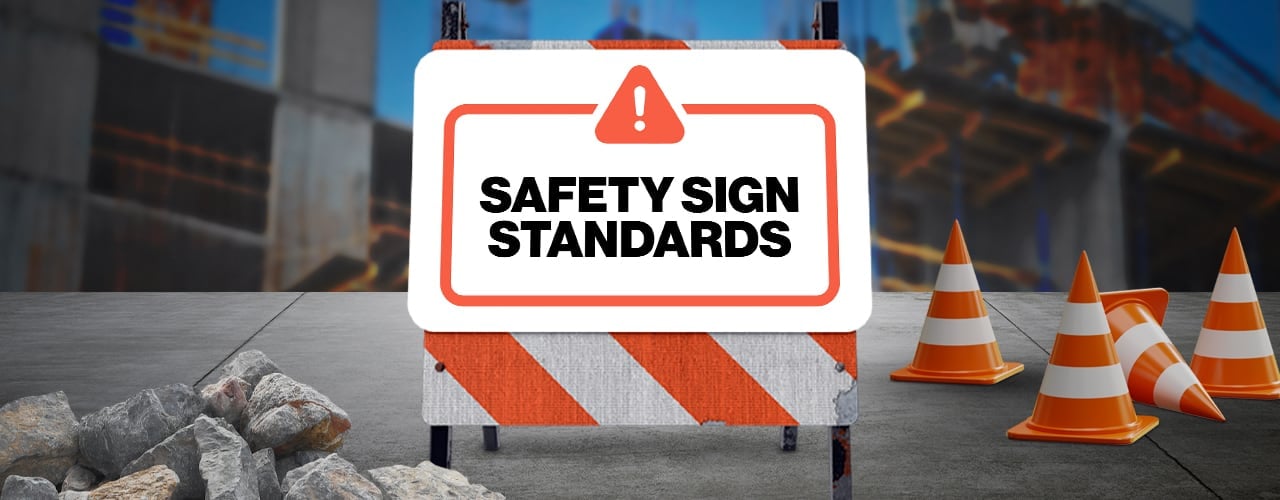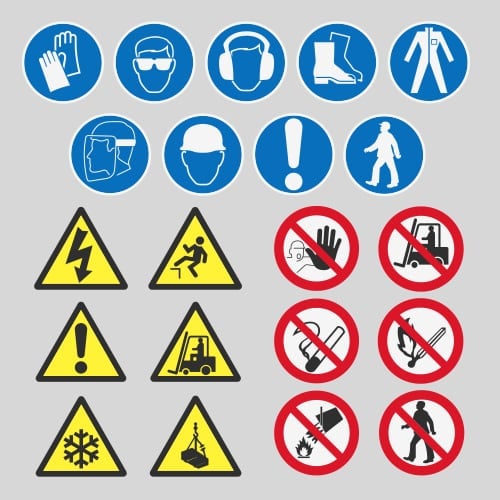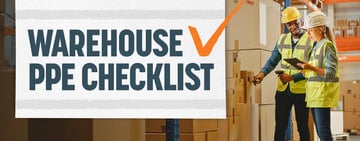
To uphold warehouse safety standards, you must understand safety sign requirements. Safety signs alert warehouse staff to potential hazards so they can avoid them. We explain what protocols your safety signs need to meet so your business complies with OSHA and ANSI standards and your staff remains safe.
Shop All Warehouse SignsOSHA Sign Requirements

OSHA provides the baseline for regulations relating to safety signs, accident prevention signs, and safety tags. OSHA’s detailed safety sign regulations are found in the 29 Code of Federal Regulation (CFR) 1910.145. Safety signs used for highways, railroads, streets, plant bulletin boards, and safety posters aren’t covered by the 29 Code of Federal Regulation (CFR) 1910.145.
Types of OSHA Safety Signs
OSHA classifies safety signs into three categories:- Danger Signs - Danger signs show there is immediate danger and that you must take special precautions. They must be red, black, or white colored to meet OSHA standards.
- Caution Signs - Caution signs reveal possible hazards and warn against unsafe procedures. They must have a yellow background and a black panel with yellow lettering. If letters appear on a yellow background, they must be black.
- Safety Instruction Signs - OSHA demands businesses use safety instruction signs when they need to provide general safety instructions or suggestions for safety measures. They need a white background, green panel, and white letters. If letters appear on a white background, they must be black.
ANSI Sign Standards
The American National Standards Institute (ANSI) outlines their specifications for accident prevention signs and their safety color code for marking physical hazards in the ANSI and NEMA (National Equipment Manufacturers Association) Z535 series of safety alerting standards. Learning common safety acronyms like ANSI and NEMA helps you locate the resources you need to maintain a safe environment. ANSI’s safety sign standards are voluntary but upholding them will make your safety signs more effective. There are six documents and a color chart within the ANSI/NEMA Z535 series. We briefly describe each below.
- Safety Colors - Color standards, tolerances, and technical definitions are outlined in ANSI Z535.1.
- Environmental Facility and Safety Signs - Details on how to create a consistent visual layout by regulating the design, application, and use of safety signs are found in ANSI Z535.2.
- Criteria for Safety Symbols - General criteria for designing, evaluating, and using safety symbols to highlight specific hazards are found in ANSI Z535.3.
- Product Safety Signs and Labels - Discover specifications on how to design, apply, use, and place safety signs and labels on products in ANSI Z535.4.
- Safety Tags and Barricade Tapes - ANSI Z535.5 provides information on the tags and tapes used when a temporary hazard or hazardous operation is present.
- Product Safety Information in Product Manuals, Instructions, and Other Collateral Materials - Manufacturers use ANSI Z535.6 to learn how to develop efficient safety messages.
Safety Signs and Symbols

Discover the most common safety signs and symbols you need in your workspace. Familiarizing yourself with these national and international standardized elements allows you to uphold ANSI and OSHA standards.
The Safety Alert Symbol
The safety alert symbol is an exclamation point surrounded by a triangle. It is a vital part of OSHA’s safety sign standards.
- What does the safety alert symbol mean? The safety alert symbol means a potential personal injury hazard is present.
- Where should you use the safety alert symbol? Use the safety alert symbol on DANGER, WARNING, and CAUTION signs, labels, and tags.
Signal Words for Safety Signs
There are three main signal words you need to be familiar with to properly interpret and place hazard alerting safety signs: DANGER, WARNING, and CAUTION. The terms NOTICE and SAFETY INSTRUCTIONS are used on safety signs as well, but they don’t warn against a hazard.
- DANGER - the signal word “DANGER” signifies that a hazard that causes serious injury or death if not avoided is present. You should only include DANGER on safety signs in the most serious instances. It’s often used for risks of crushing or pinching.
- WARNING - the signal word “WARNING” signifies a hazardous situation that could cause serious injury or death if not avoided. Images of required PPE often appear alongside the WARNING text.
- CAUTION - the signal word “CAUTION” signifies a hazardous situation that could cause a minor to moderate injury. The CAUTION signal word often warns against slipping or tripping hazards.
- NOTICE - the signal word “NOTICE” signifies important information that isn’t directly related to a hazard.
- SAFETY INSTRUCTIONS - the signal words “SAFETY INSTRUCTIONS” prelude information on how to execute safety procedures.
Safety Symbols
Safety symbols and graphics are used on safety signs to draw attention and bridge language barriers. There are universal shape, color, and design principles for safety symbols that adhere to global compliance standards.
- Health Hazard Symbol - looks like a human bust with fissures in its chest and is used to indicate aspiration toxicity, carcinogen, target organ toxicity, mutagenicity, respiratory sensitizer, and reproductive toxicity.
- Flame - looks like a fire and is used to indicate flammables, organic peroxides, pyrophorics, self-reactives, self-heating, and flammable gas emissions.
- Exclamation Mark - looks like a black exclamation mark and indicates hazards to the ozone layer, irritants to the skin and eyes, respiratory tract irritants, skin sensitizers, narcotic effects, and acute toxicity.
- Gas Cylinder - looks like a black gas cylinder and indicates gases under pressure.
- Corrosion - looks like two vials, each pouring liquid. One vial pours liquid onto a pipe and the other onto a human hand. Both liquids cause damage. This symbol indicates corrosion/burns to skin, eye damage, and metal corrosion.
- Exploding Bomb - looks like a black circle with lines emitting from it and indicates explosives, organic peroxides, and self-reactives.
- Flame Over Circle - looks like a black circle with flames sitting atop it and it indicates oxidizers.
- Environment - looks like branches and a fish and it indicates aquatic toxicity.
- Skull and Crossbones - looks like skull and crossbones and indicates fatal toxicity.
Back to Top
Warning Sign Colors

Safety signs use colors to indicate warnings. While words can be misunderstood due to language barriers and symbols can become hard to identify during a crisis, colors quickly and effectively provide warnings on safety signs. Discover the color codes of both ANSI/NEMA Z535.1-2006 (R2017) and OSHA below.
1. Red Safety Signs
- Meaning - Danger, stop
- Applications - Indicate fire equipment, highlight an emergency stop bar and/or button on machinery
2. Fluorescent Orange / Orange-Red Safety Signs
- Meaning - Biosafety
- Applications - Containers and labels used for infectious waste and blood
3. Yellow Safety Signs
- Meaning - Caution
- Applications - Tripping/falling/striking hazards, “Flammable, Keep Fire Away” labels, containers, and safety cans used for explosives, unstable materials, and corrosives
4. Orange Safety Signs
- Meaning - Warning
- Applications - Indicates parts of energized equipment and machinery that could cause injuries
5. Green Safety Signs
- Meaning - Safety
- Applications - Highlighting the location of first aid equipment, safety equipment, safety showers, and other safety tools
6. Blue Safety Signs
- Meaning - Information
- Applications - Bulletin boards, signs, and railroad warnings
7. Black, White, Yellow, or a Combination of Black with White or Yellow Safety Signs
- Meaning - Boundaries
- Applications - Traffic markings, housekeeping markings
8. Magenta or Purple on Yellow Safety Signs
- Meaning - Radiation caution
- Applications - X-ray, gamma, beta, neutron, and proton radiation
Back to Top
Safety Sign Text Sizing Requirements

ANSI requires safety sign text to be concise and easy to read with lettering sizing that enables a person with normal (including corrected) vision to read the safety message panel from a safe distance from the hazard. A minimum safe viewing distance is the closest a person can get to the sign and still have time to follow the safety panel’s instructions and avoid the hazard. The signal word in the message panel must be a minimum of 50% greater than the height of a capital H. Refer to the safety sign letter sizing table below to see what letter height is required for common safe viewing distances and conditions.
| Minimum Safe Viewing Distance (ft.) | Minimum Letter Height for Good Reading Conditions (in.) | Minimum Letter Height for Bad Reading Conditions (in.) |
|---|---|---|
| 4 | 0.16 | 0.33 |
| 6 | 0.24 | 0.50 |
| 8 | 0.32 | 0.66 |
| 10 | 0.40 | 0.83 |
| 15 | 0.60 | 1.27 |
| 20 | 0.80 | 1.68 |
| 30 | 1.20 | 2.51 |
| 40 | 1.60 | 3.36 |
| 60 | 2.40 | 5.04 |
| 80 | 3.20 | 6.72 |
| 100 | 4.00 | 8.40 |
| 125 | 5.00 | 10.49 |
| 150 | 6.00 | 12.58 |
| 200 | 8.00 | 16.79 |
Back to Top
Where Should Safety Signs Be Placed?
You should place safety signs anywhere hazards exist. ANSI Z535.2-2011 (R2017) lays out the following safety sign placement requirements:
- Safety and fire safety equipment signs must be visible and near the equipment itself.
- Place safety signs where they won’t fade or suffer damage from environmental conditions.
- If needed, safety signs must have illumination or retro reflectiveness to provide legibility under normal operating conditions.
- Use supplemental illumination when illumination is inadequate and safety colors are unclear.
- If the sign is positioned where illumination may be interrupted, make the sign with materials that are photo luminescent and/or retroreflective. You may also need to provide emergency lighting.
- Your safety signs must not distract from the hazard itself.
- Do not place the safety sign on or adjacent to movable objects.
Back to Top
Ensure your business complies with safety standards by adhering to OSHA's safety sign stipulations. Follow ANSI's voluntary standards to maximize the effectiveness of your safety signs. If you encounter questions when adding safety signs to your warehouse layout, reference back to our safety sign standards guide to help prevent accidents and injuries.





